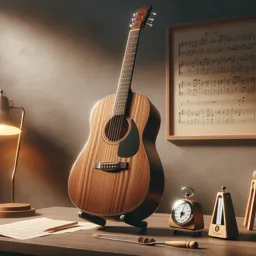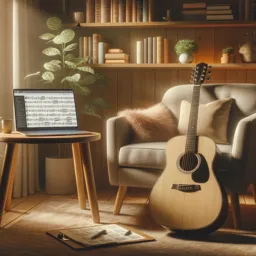Developing an effective practice routine is essential for any guitarist looking to improve their skills and progress in their musical journey. A well-structured practice routine helps maintain focus, build technique, and keep motivation high. This article provides tips on building a practice routine that works for you, setting achievable goals, and staying motivated to continue improving as a guitarist.
Setting Goals
- Short-Term Goals
- Set specific, achievable short-term goals to provide direction and a sense of accomplishment. These could include learning a new song, mastering a particular technique, or improving your speed and accuracy on scales.
- Examples:
- Learn the chord progression of a new song.
- Practice alternate picking for 15 minutes daily.
- Increase metronome speed by 5 BPM each week.
- Long-Term Goals
- Define long-term goals to keep you motivated and provide a roadmap for your practice. These goals should be ambitious yet realistic and broken down into manageable steps.
- Examples:
- Perform at a local open mic night.
- Record and release your own music.
- Master advanced techniques like sweep picking or tapping.
Structuring Your Practice Routine
- Warm-Up Exercises
- Start your practice session with warm-up exercises to prepare your fingers and hands. This helps prevent injury and improves dexterity and coordination.
- Examples:
- Finger stretches and hand exercises.
- Simple scales and chromatic exercises.
- Light strumming or fingerpicking patterns.
- Technical Drills
- Allocate time for technical drills to build and refine your playing technique. Focus on areas that need improvement and gradually increase the complexity.
- Examples:
- Scales and arpeggios.
- Chord changes and progressions.
- Picking exercises (alternate, economy, hybrid).
- Repertoire Practice
- Spend a portion of your practice time working on songs you are learning or refining. This helps apply techniques in a musical context and keeps practice sessions enjoyable.
- Examples:
- Break down difficult sections of a song.
- Play along with backing tracks or a metronome.
- Experiment with different arrangements or styles.
- Improvisation and Creativity
- Dedicate time to improvisation and creative exploration to develop your musical expression and creativity. This can also improve your understanding of music theory and fretboard navigation.
- Examples:
- Improvise over backing tracks or chord progressions.
- Create your own riffs and licks.
- Experiment with different scales and modes.
- Review and Reflect
- End your practice session by reviewing what you have worked on and reflecting on your progress. Take note of areas that need more attention and adjust your practice routine accordingly.
- Examples:
- Record your practice sessions and listen back to identify strengths and weaknesses.
- Keep a practice journal to track your goals, progress, and challenges.
- Set new goals based on your reflections.
Staying Motivated
- Variety and Challenge
- Keep your practice routine interesting by incorporating variety and challenging yourself with new material and techniques. Avoid monotony to maintain motivation.
- Examples:
- Rotate between different genres and styles.
- Set weekly or monthly challenges (e.g., learn a solo, compose a piece).
- Join a guitar community or take online courses for new ideas.
- Accountability and Support
- Find ways to stay accountable and seek support from others. Sharing your progress and receiving feedback can boost motivation and provide valuable insights.
- Examples:
- Take lessons from a guitar teacher or coach.
- Join a band or music group.
- Participate in online forums or social media groups for guitarists.
- Celebrate Achievements
- Celebrate your achievements, no matter how small, to stay motivated and recognize your progress. Acknowledge the effort you put into your practice and enjoy the journey.
- Examples:
- Record a video of your performance and share it with friends.
- Treat yourself to new guitar gear or accessories.
- Set up a small performance for family or friends.
Conclusion
Building a structured and effective practice routine is key to progressing as a guitarist. By setting clear goals, structuring your practice sessions, and staying motivated, you can make consistent improvements and enjoy your musical journey. Remember to balance technical practice with creativity and always keep the joy of playing guitar at the forefront. With dedication and a well-crafted practice routine, you can achieve your musical aspirations and continue to grow as a guitarist.

























